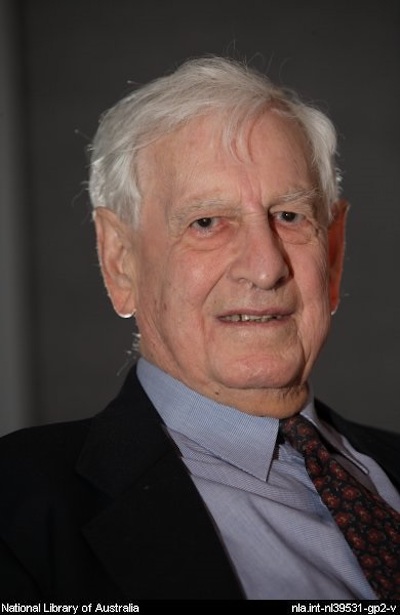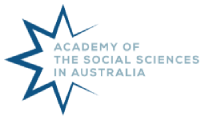Jubilee Fellow – 2014

Emeritus Professor John Legge AO
was appointed to the foundation Chair of History at Monash University in 1960. From 1964 till 1986 he chaired the Monash Centre of Southeast Asian Studies. In 1969–70 he was Director of the Singapore Institute of Southeast Asian Studies. From 1978 to 1986 he was Dean of the Monash Faculty of Arts. In 1987–93 he was an Executive Member on the Victorian Curriculum and Assessment Board.
His main area of interest has been Indonesian history. His written work includes a study of regionalism and local government in Indonesia (1962), a biography of Sukarno (1972, 1985, and 2003), and Intellectuals and Nationalism in Indonesia (1988), an examination of the group which formed about Sutan Sjahrir during the Japanese occupation and became the core of the Indonesian Socialist Party during the evolution. He is also a Fellow of the Academy of the Humanities.
2014 Reflections
Like Professor Taft, I am honoured by the actions of the Academy in giving me this award. I recall that when discussions about the formation of an Academy began one distinguished historian resisted the idea. He argued that the variety of existing scholarly contacts were sufficient, citing the Australian & New Zealand Association for the Advancement of Science (ANZAAS) meetings of the 1950s and 1960s, and the Social Science Research Council, the Academy’s predecessor, organised in Canberra by Herbert Burton. He went on to describe the creation of an Academy as ‘pretentious’. After the Chairman’s pencil fell it was clear the idea of the Academy carried the day. The foundational purpose of the Academy would be to deal with practical challenges facing tertiary institutions.
The Academy performs a function that couldn’t be performed by the other institutions, such as unifying perceptions of social science work. Monash, for example, came into being at a time when choices had to be made between whether one should go for faculties and departments in organising a university, or along the lines of ‘schools of study’ under which institutions would be shaped by overall conceptions of what should be studied. ANZAAS also did not provide universities with directives or avenues for social scientists to work in common with scientists, physicists, and chemists. It was more a case of organising travel and annual meetings and working within existing expectations of what would be studied. Within ANZAAS institutions would be shaped, not by general goals of common study, but by the activity of scholars working at meetings each year with other scholars whom they already knew. The Academy, by contrast, was established to push into new areas of study and foster development outside of these expectations.
The study of Asia at Australian schools and universities before the Second World War was limited in scope and in focus. But in the post-war world, the development of studies of Southeast Asia were made very much under the influence of social science type enquiries. My movement towards involvement coincided with a social science approach to these studies, a new leaning towards a social science paradigm in the study of Southeast Asia, providing new questions to be answered. My development of the Centre of Southeast Asian Studies at Monash University reflected that influence and one, I think, important contribution that I made was a chapter on the study of Southeast Asia in the Cambridge History of Southeast Asia.
When I began my study of Indonesia, the Cornell Modern Indonesia Project was of great assistance to me and took me into a different world, which provided a specific approach to the subject matter. In a way, with the formation of the Academy, one took a different attitude towards other organisations, which had their own specific approaches to the study of Asia. I was able to benefit from that as well as the new kinds of contacts that could be found through the Academy.
I had initially been interested in the Western Pacific in the 19th century and worked in that direction but suddenly took a dramatic turn towards Southeast Asia itself. In 1944 I began to learn Indonesian and two years later, aided by a Carnegie Fellowship, I headed for Cornell, the leading centre of Southeast Asian studies. At the end of my Cornell semester came the next part of the plan—fieldwork in Indonesia focusing on local government. Across the United States by car, over the Pacific by Dutch cargo ship, to Singapore via the Philippines and then by KPM ship to Java. That six months was to be the first of what became more or less annual visits to Indonesia. In subsequent years I moved away from a concern with local government to more general questions of Indonesian history and politics.
In 1960 I was appointed to the Chair of History at the newly established Monash University. In 1964 the university created a Centre of Southeast Asian Studies and my involvement in this is my proudest achievement. In 1969, I was appointed Director of the newly founded Singapore Institute of Southeast Asian Studies for a 12-month period. One might also mention I was convenor of a series of papers titled Traditional Attitudes and Modern Styles in Political Leadership (1971), which was presented to the 28th International Congress of Orientalists. In May 1976, I was elected the first President of the Asian Studies Association of Australia.
In future the Academy should continue to provide scholars with a different approach. The Academy meetings and the contacts that one made at these meetings, provided a breadth of easy association with people sharing ones specific subject authority.
